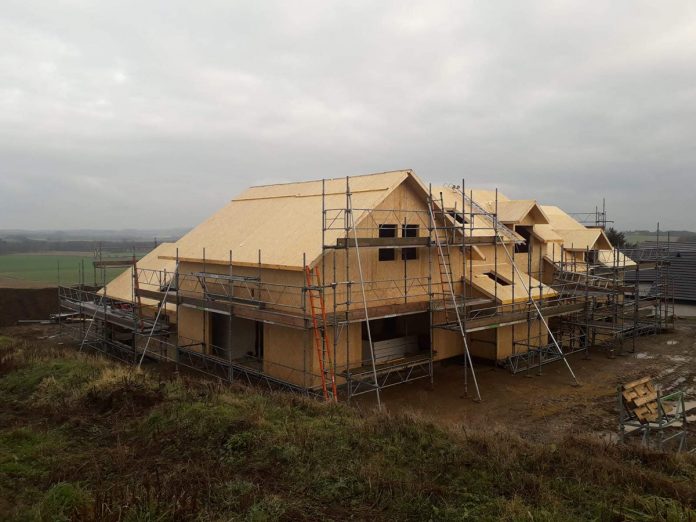Significant growth for structural insulated panels (SIPs), as clients seek to construct energy-efficient homes and reduce running costs
Sometimes the best ideas arise from situations which you didn’t necessary wish for or plan. JML Contracts, based in Perthshire, Scotland, started out over 15 years ago, primarily as a civil engineering and construction company under the leadership of John Langley. The business undertook a wide range of contracts, specialising in groundworks and retention systems.
JML began working with a structural insulated panels (SIPs) company, installing the foundations and drainage for the houses they were building, and detailing the precise requirements of the foundations to ensure this met with the exact factory cut dimensions of the SIPs kit.
Sadly, the SIPs business ceased trading – leaving a client with a kit still to put up. JML had observed the construction of many SIPs buildings during the time they had worked with their SIPs partner, so they offered to carry out and finish the project in a short timeframe.
From this unfortunate circumstance came an opportunity for JML.
John Langley identified a gap in the market in Scotland for SIPs, while also deciding to make improvements in the design and construction methods to benefit the overall finished product. JML began processing and erecting their own SIPs building kits, using their knowledge and previously gained experience.
Fast forward to today and, despite the uncertain economic climate, JML Contracts’ SIPs division, JML Low Energy Homes, has a healthy order book of current and future works, with enquiries continuing to come in. The company has seen a significant increase in demand for SIPs projects and in this article, we discussed with Derek McIntyre, commercial manager at JML SIPs, why they are advocates of this modern and effective construction solution.
The key benefits of SIPs compared to traditional construction start with thermal efficiency
“SIPs provide the basis for a superior form of construction, compared with traditional building methods.” That is the first message from Derek, referencing the ease with which an airtight building envelope can be created. SIPs buildings achieve extremely high levels of energy efficiency and form a structure that is strong and durable.
This airtightness gives an excellent thermal performance rating and a constant temperature, providing substantive benefits in terms of lower operating costs – and sustainability reducing energy use.
SIPs create a tight shell structure, which in turn allows for much more efficient heating and ventilation systems. Almost all JML’s SIPs houses use an air source heat pump to provide the heating and hot water, with exceptionally low running costs. Off-grid houses constructed by JML require only a low heat load to provide heating, powered entirely from solar panels.
Maximising internal space
Maximising the use of space is another crucial benefit. The SIPs system is effectively a single-shell structure, which in itself is thermally efficient and load-bearing, providing much greater internal space.
Once the walls and roof are constructed, the load is spread over the entire area of the structure. This is different from a timber kit, which requires each individual timber to transfer the load.
Furthermore, by using SIPs for roofing structures it automatically creates a cathedral-style building, providing a clear, open space on first floors and creating vaulted spaces above living areas with ease. Therefore, the first-floor space can be used in its entirety without losing space to roof trusses.
Total build cost
Of course, the build cost is always a critical issue. It is of fundamental importance to understand the total costs of a project when comparing SIPs with other forms of timber framed construction. For example, after erecting your SIPs building it is a fully insulated shell, ready to be fitted out. Yet, a timber frame at the same stage then requires fitting by a competent tradesman; often the cost of these follow-on works and the additional time on-site carrying out these stages is not included when comparing the options. In terms of the most cost-effective builds, 1.5 storey style houses with a second storey living area and those with vaulted ceilings are potential solutions.
Speed of build
Speed is another benefit of using SIPs in construction projects, whether these are for a residential, commercial or industrial purpose. SIPs are a dual offsite (within a factory environment) and on-site form of construction. SIPs buildings can be erected quickly, with the site time minimised in comparison to other systems due to the offsite manufacturing process.
EPS/XPS vs PU: Which one is best to use?
SIPs are made essentially with a choice of two different cores. The longstanding debate between the different cores – EPS/XPS compared to PU – is an issue on which Derek gives a firm opinion.
Insulation is key to making buildings more sustainable by making them more thermally efficient. However, it is extremely important to address the embodied impact of each material.
While both EPS/XPS and PU will achieve the same outcome in terms of an energy efficient home, there are crucial differences.
Firstly, to achieve the same thermal performance of the panel, the PU panel generally does not need to be as thick as the EPS/XPS panel. This means that wall and roof thicknesses can be kept to a minimum and therefore maximise internal space.
Secondly, the structural strength of the PU panel is greater, allowing it to span greater distances, meaning there is less need for additional support and purlins creating clear open spaces to be incorporated into designs.
While the raw material cost of the EPS/XPS panel is less to start with, the additional structure required generally offsets this cost saving, meaning there is minimal difference in the overall cost.
The EPS/XPS is essentially a slab of polystyrene glued between two sheets of OSB board.
The PU panel is formed in a press with the PU being injected into the panel, which is held under pressure until it sets. This creates an incredibly strong bond between the OSB and PU, giving the panel its strength while also providing a better thermal insulation value.
Why understanding more about SIPs is crucial to further grow the market
SIPs are a proven, high performance building system for residential and commercial construction. So, despite the use of SIPs in the UK now becoming more mainstream, why is there still a reluctance to use this cost and energy effective material among some industry professionals?
In Derek’s view, a lack of education and good quality information is a factor, as many architects, surveyors, engineers and project managers are not aware of how to use this material in construction. Therefore, the JML team spend considerable time attending building exhibitions and giving CPD presentations to architects to explain and promote the use of SIPs. This helps to promote the benefits and address any uncertainties – and ensure that SIPs are regarded as a viable alternative to traditional methods.
The firm also takes time to explain how SIPs work, with individual clients who are unsure whether to use this method. Once it is described in greater detail, people have a better understanding of the system and they are generally sold on the principle.

Building warranties
The company already has a strong foothold in the self-build market, with clients attracted by the stringent Building Regulation warrants that the firm adheres to, as well as the thermal, acoustic and structural properties of SIPs. JML is further encouraged by increased interest in the commercial sector, schools and education, as well as from local authorities. For instance, Glasgow City Council is pledging a commitment to passive social housing, which could provide a good opportunity for the firm with its offsite capabilities, and harness the thermal efficiencies of the SIPs product.
Furthermore, in recent months the company has seen significant interest from clients who want to use SIPs to build a range of garden rooms, home offices and garden annexes.
JML SIPs has added a new ‘iso pod’ range to meet the recent increase in demand from people working from home and home-schooling their children.
The world has changed – and people are adapting to the new reality
- Sustainable construction.
- Reduced energy consumption.
- Application of green technologies.
- The use of fewer and better quality materials, with very limited site wastage.
- Quicker builds.
- Aesthetic design.
These are all qualities that SIPs offer and due to the current crisis, people are reassessing their priorities. It could be argued that there has never been a more fruitful time for this modern method of construction.
The team at Hemsec would like to thank Derek McIntyre and colleagues at JML SIPs for their time and contribution to produce this article. JML has been using Hemsec panels for around four years now and we value our relationship, as well as the opportunity to make a reality of an increasing number of bespoke SIPs projects in Scotland and further afield.
Hemsec supplies SIPs to JML under a Product BBA rather than a System BBA. This means that an installer only needs to comply with Building Regs, Hemsec’s BBA guidelines and the tolerances of our declaration of performance to qualify as an installer. We know that our products are of such high quality, we do not need to rely on the specification and assurances of other system elements.
The future is indeed looking bright for JML – and for SIPs manufacturers and installers.














